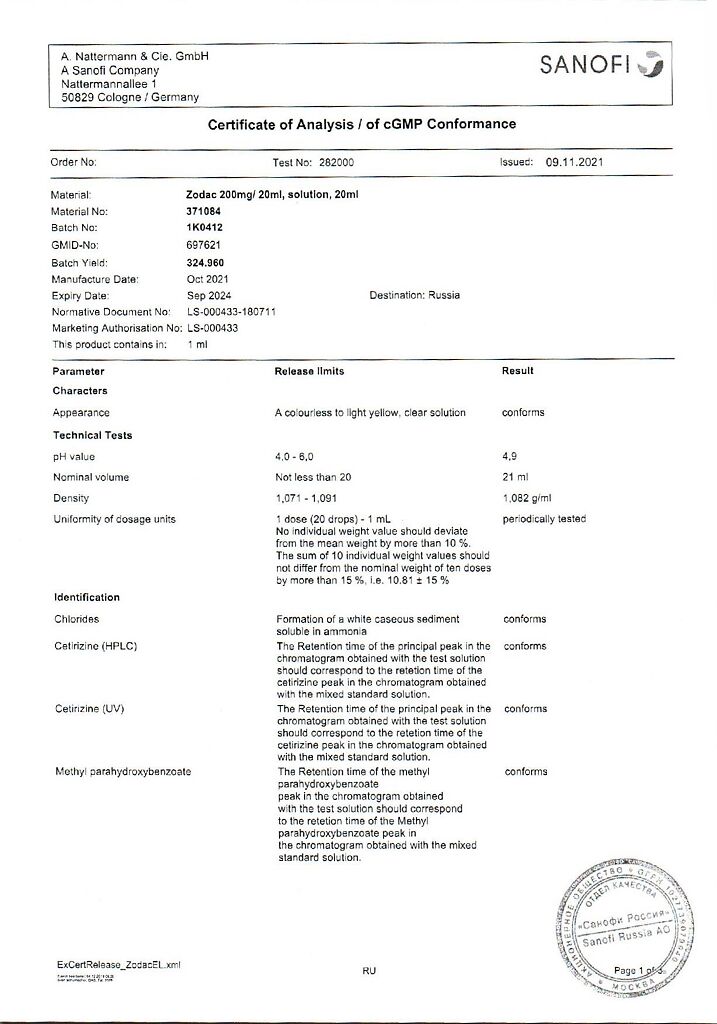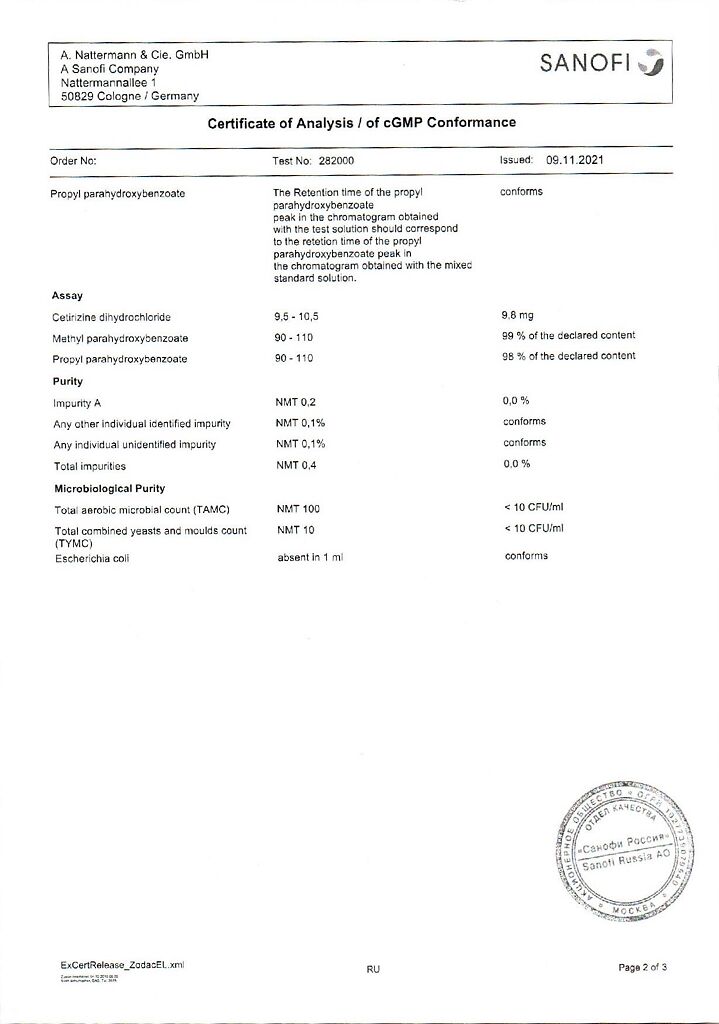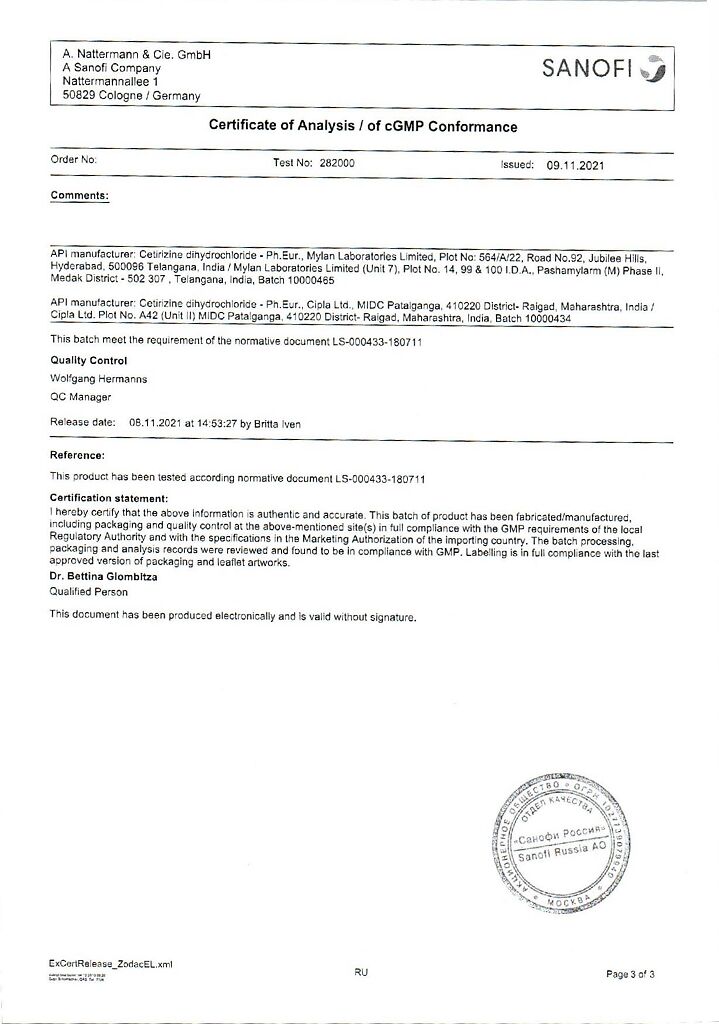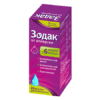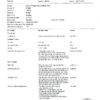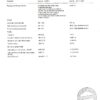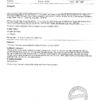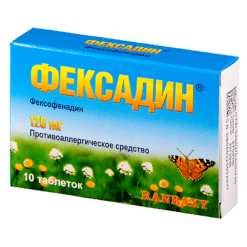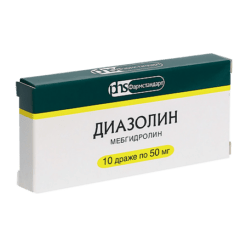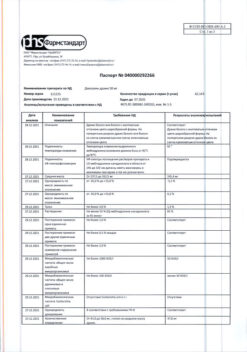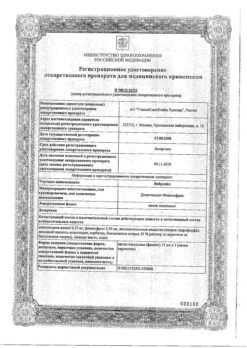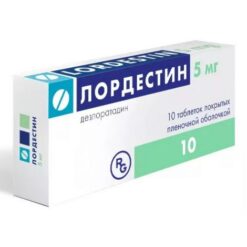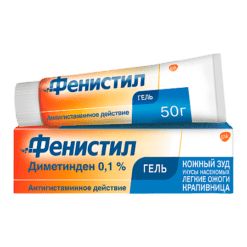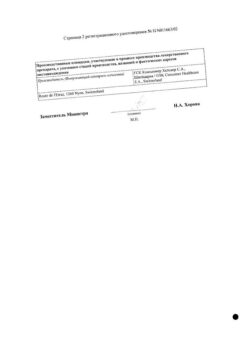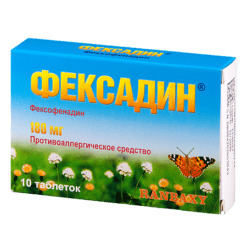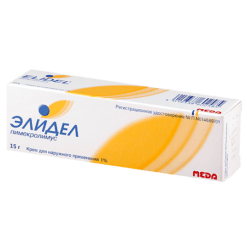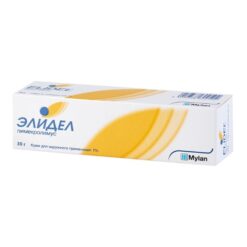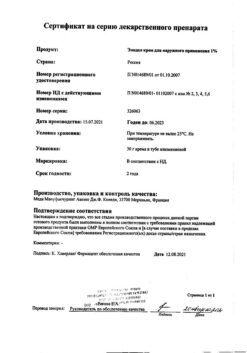No products in the cart.
Description
Cetirizine is a metabolite of hydroxyzine, belongs to the group of competitive histamine antagonists and blocks H1-histamine receptors.
In addition to its antihistamine effect, cetirizine prevents the development and facilitates the course of allergic reactions: in a dose of 10 mg once or twice daily, it inhibits the late phase of eosinophil aggregation in the skin and conjunctiva of atopic patients. After oral administration, the antiallergic effect of cetirizine lasts for 24 hours.
Clinical efficacy and safety:
Studies in healthy volunteers have shown that cetirizine at doses of 5 or 10 mg significantly inhibits the reaction in the form of rash and redness to high concentrations of histamine injected into the skin, but no correlation with efficacy has been established.
In a 6-week placebo-controlled study involving 186 patients with allergic rhinitis and concomitant mild to moderate bronchial asthma, cetirizine in a dose of 10 mg once daily was shown to reduce rhinitis symptoms and not affect lung function.
The results of this study confirm the safety of the use of cetirizine in patients with allergies and mild to moderate bronchial asthma.
The placebo-controlled study showed that the use of cetirizine in a dose of 60 mg daily for 7 days did not cause clinically significant prolongation of the QT interval. Administration of cetirizine in the recommended dose showed improvement of quality of life in patients with year-round and seasonal allergic rhinitis.
Children
A 35-day study involving patients aged 5-12 years showed no evidence of insensitivity to the antihistamine effect of cetirizine. Normal skin response to histamine was restored within three days of drug withdrawal with repeated use.
A 7-day placebo-controlled study of cetirizine in a syrup form involving 42 patients aged 6 to 11 months demonstrated the safety of its use. Cetirizine was administered at a dose of 0.25 mg/kg twice daily, which approximated 4.5 mg per day (the dose range was 3.4 to 6.2 mg per day).
The use in children from 6 to 12 months of age is only possible by prescription and under strict medical supervision.
Pharmacokinetics
The pharmacokinetic parameters of cetirizine change linearly when used in doses from 5 to 60 mg.
Intake
The maximum concentration (Cmax) in plasma is reached after 1 ±0.5 hours and is 300 ng/ml.
The various pharmacokinetic parameters such as maximum plasma concentration and area under the concentration-time curve are homogeneous. Food intake does not affect the completeness of cetirizine absorption, although its rate is reduced. The bioavailability of different dosage forms of cetirizine (solution, capsules, tablets) is comparable.
Distribution
Cetirizine is 93 ± 0.3% bound to blood plasma proteins. The volume of distribution (Vd) is 0.5 l/kg. Cetirizine does not affect the binding of warfarin to proteins.
Metabolism
Cetirizine does not undergo extensive primary metabolism.
Elimation
The elimination half-life (T1/2) is approximately 10 hours.
No cetirizine cumulation was observed when using the drug in a daily dose of 10 mg for 10 days.
Approximately 2/3 of the dose taken is excreted unchanged in the urine.
Elderly patients
The T1/2 was 50% higher and clearance was 40% lower in 16 elderly patients at a single dose of 10 mg compared to non-elderly patients.
The decreased clearance of cetirizine in elderly patients is probably due to decreased renal function in this patient population.
Patients with renal impairment
In patients with mild renal impairment (creatinia clearance (CK) > 40 ml/min) pharmacokinetic parameters are similar to those in healthy volunteers with normal renal function.
In patients with moderate renal insufficiency and in patients on hemodialysis (CK < 7 ml/min), when using the drug orally at a dose of 10 mg, T1/2 is prolonged by 3 times and total clearance is reduced by 70% relative to healthy volunteers with normal renal function.
In patients with moderate to severe renal impairment, an appropriate change in dosing regimen is required.
Cetirizine is poorly excreted by hemodialysis.
Patients with hepatic impairment
Patients with chronic liver disease (hepatocellular, cholestatic and biliary cirrhosis) have a T1/2 increased by approximately 50% and clearance decreased by 40% in a single dose of 10 or 20 mg compared to healthy subjects. Dose adjustment is necessary only if the patient with hepatic impairment also has concomitant renal impairment.
Children
The T1/2 in children 6 to 12 years old is 6 hours, 2 to 6 years old is 5 hours, and 6 months to 2 years old is reduced to 3.1 hours.
Indications
Indications
Indicated in adults and children 6 months and older to relieve:
nasal and ocular symptoms of year-round (persistent) and seasonal (intermittent) allergic rhinitis and allergic conjunctivitis: itching, sneezing, nasal congestion, rhinorrhea, lacrimation, conjunctival hyperemia;
symptoms of chronic idiopathic urticaria.
Pharmacological effect
Pharmacological effect
Cetirizine is a metabolite of hydroxyzine, belongs to the group of competitive histamine antagonists and blocks H1-histamine receptors.
In addition to the antihistamine effect, cetirizine prevents the development and alleviates the course of allergic reactions: at a dose of 10 mg 1 or 2 times a day, it inhibits the late phase of eosinophil aggregation in the skin and conjunctiva of patients prone to atopy. After oral administration, the antiallergic effect of cetirizine lasts for 24 hours.
Clinical efficacy and safety:
Studies in healthy volunteers have shown that cetirizine at doses of 5 or 10 mg significantly inhibits the rash and redness response to high concentrations of histamine in the skin, but the correlation with efficacy has not been established.
A 6-week placebo-controlled study involving 186 patients with allergic rhinitis and concomitant mild to moderate bronchial asthma showed that the use of cetirizine at a dose of 10 mg 1 time per day reduced the symptoms of rhinitis and did not affect pulmonary function.
The results of this study confirm the safety of cetirizine in patients suffering from allergies and mild to moderate bronchial asthma.
A placebo-controlled study showed that the use of cetirizine at a dose of 60 mg per day for 7 days did not cause a clinically significant prolongation of the QT interval. The use of cetirizine at the recommended dose has shown an improvement in the quality of life of patients with year-round and seasonal allergic rhinitis.
Children
In a 35-day study in patients aged 5-12 years, there was no evidence of resistance to the antihistamine effect of cetirizine. The normal skin reaction to histamine was restored within three days after discontinuation of the drug with repeated use.
A 7-day placebo-controlled study of cetirizine syrup in 42 patients aged 6 to 11 months demonstrated its safety. Cetirizine was prescribed at a dose of 0.25 mg/kg twice daily, which corresponds to approximately 4.5 mg per day (dose range was 3.4 to 6.2 mg per day).
Use in children from 6 to 12 months is possible only as prescribed by a doctor and under strict medical supervision.
Pharmacokinetics
The pharmacokinetic parameters of cetirizine when used in doses from 5 to 60 mg change linearly.
Suction
The maximum concentration (Cmax) in blood plasma is reached after 1 ± 0.5 hours and is 300 ng/ml.
Various pharmacokinetic parameters, such as maximum plasma concentration and area under the concentration-time curve, are homogeneous. Food intake does not affect the complete absorption of cetirizine, although its rate decreases. The bioavailability of various dosage forms of cetirizine (solution, capsules, tablets) is comparable.
Distribution
Cetirizine is 93 ± 0.3% bound to plasma proteins. The volume of distribution (Vd) is 0.5 l/kg. Cetirizine does not affect the protein binding of warfarin.
Metabolism
Cetirizine does not undergo extensive first-pass metabolism.
Removal
The half-life (T1/2) is approximately 10 hours.
When using the drug at a daily dose of 10 mg for 10 days, no accumulation of cetirizine was observed.
Approximately 2/3 of the dose taken is excreted unchanged in the urine.
Elderly patients
In 16 elderly patients, with a single dose of 10 mg, T1/2 was 50% higher and clearance was 40% lower compared to non-elderly patients.
The decreased clearance of cetirizine in elderly patients is likely due to decreased renal function in this category of patients.
Patients with renal failure
In patients with mild renal failure (creatinine clearance (CC) > 40 ml/min), pharmacokinetic parameters are similar to those in healthy volunteers with normal renal function.
In patients with moderate renal failure and in patients on hemodialysis (creatinine clearance <7 ml/min), when using the drug orally at a dose of 10 mg, T1/2 is extended by 3 times, and total clearance is reduced by 70% relative to healthy volunteers with normal renal function.
For patients with moderate or severe renal impairment, appropriate changes in the dosage regimen are required.
Cetirizine is poorly excreted from the body during hemodialysis.
Patients with liver failure
In patients with chronic liver diseases (hepatocellular, cholestatic and biliary cirrhosis), with a single dose of 10 or 20 mg, T1/2 increases by approximately 50%, and clearance decreases by 40% compared to healthy subjects. Dose adjustment is only necessary if the patient with hepatic insufficiency also has concomitant renal insufficiency.
Children
T1/2 in children from 6 to 12 years is 6 hours, from 2 to 6 years – 5 hours, from 6 months to 2 years is reduced to 3.1 hours.
Special instructions
Special instructions
Due to the potential depressant effect on the central nervous system, caution should be exercised when prescribing Zodak® to children under 1 year of age in the presence of the following risk factors for sudden infant death syndrome, such as (but not limited to):
sleep apnea syndrome or sudden infant death syndrome in a sibling;
maternal drug abuse or smoking during pregnancy;
young maternal age (19 years and younger);
Smoking abuse by a nanny caring for a child (one pack of cigarettes a day or more);
children who regularly fall asleep face down and are not placed on their back;
premature (gestational age less than 37 weeks) or low birth weight (below the 10th percentile of gestational age) children;
when taking drugs together that have a depressant effect on the central nervous system. The drug contains excipients methylparabenzene and propylparabenzene, which can cause allergic reactions, including delayed ones.
In patients with spinal cord injury, prostatic hyperplasia, or other predisposing factors to urinary retention, caution is required as cetirizine may increase the risk of urinary retention. Caution is recommended when using cetirizine concomitantly with alcohol, although no clinically significant interaction with alcohol was observed at therapeutic doses (at a blood alcohol concentration of 0.5 g/l).
Caution should be observed in patients with epilepsy and increased convulsive readiness.
Before prescribing allergy tests, a three-day “washing out” period is recommended due to the fact that H1-histamine receptor blockers inhibit the development of skin allergic reactions.
Impact on the ability to drive vehicles and operate machinery
An objective assessment of the ability to drive vehicles and operate machinery did not reliably reveal any adverse events when using the drug Zodak® in recommended doses. However, for patients with symptoms of drowsiness while taking the drug during the treatment period, it is advisable to refrain from driving a car, engaging in potentially hazardous activities, or operating machinery that requires increased concentration and speed of psychomotor reactions.
Active ingredient
Active ingredient
Cetirizine
Composition
Composition
1 ml contains:
active substance:
Cetirizine dihydrochloride 10 mg
excipients:
Methyl parahydroxybenzoate,
propyl parahydroxybenzoate,
glycerol,
propylene glycol,
sodium saccharinate dihydrate,
sodium acetate trihydrate,
glacial acetic acid,
purified water.
Pregnancy
Pregnancy
Pregnancy
An analysis of prospective data from more than 700 cases of pregnancy outcomes revealed no cases of malformations, embryonic or neonatal toxicity with a clear cause-and-effect relationship.
Experimental studies in animals have not revealed any direct or indirect adverse effects of cetirizine on the developing fetus (including in the postnatal period), pregnancy and postnatal development.
Adequate and strictly controlled clinical studies on the safety of the drug during pregnancy have not been conducted, therefore Zodak® should not be used during pregnancy.
Breastfeeding
Cetirizine is excreted in breast milk in concentrations ranging from 25% to 90% of the drug concentration in the blood plasma, depending on the time after administration. During breastfeeding, it is used after consultation with a doctor, if the expected benefit to the mother outweighs the potential risk to the child.
Fertility
Available data on the effects on human fertility are limited, but no adverse effects on fertility have been identified.
Contraindications
Contraindications
Hypersensitivity to cetirizine, hydroxyzine or piperazine derivatives, as well as other components of the drug;
end-stage renal failure (CC < 10 ml/min);
children under 6 months of age (due to limited data on effectiveness and safety);
pregnancy.
With caution
Side Effects
Side Effects
From the digestive system: dry mouth, dyspepsia.
From the central nervous system: headache, drowsiness, fatigue, dizziness, agitation, migraine.
Allergic reactions: skin rash, angioedema, urticaria, itching.
Interaction
Interaction
No drug interactions of cetirizine with other drugs were observed.
Based on the results of drug interaction studies of cetirizine, in particular, interaction studies with pseudoephedrine or theophylline at a dose of 400 mg per day, no clinically significant interactions were established.
Concomitant use of cetirizine with alcohol and other drugs that depress the central nervous system may further reduce concentration and reaction speed, although cetirizine does not enhance the effect of alcohol (at a blood concentration of 0.5 g/l).
Overdose
Overdose
The clinical picture observed with an overdose of cetirizine was due to its effect on the central nervous system.
Symptoms: after a single dose of cetirizine at a dose of 50 mg, the following clinical picture was observed: confusion, diarrhea, dizziness, fatigue, headache, malaise, mydriasis, itching, anxiety, sedation, drowsiness, stupor, tachycardia, tremor, urinary retention.
Treatment: immediately after taking the drug, it is necessary to perform gastric lavage or induce vomiting. It is recommended to take activated carbon and carry out symptomatic and supportive therapy. There is no specific antidote. Hemodialysis is ineffective.
Storage conditions
Storage conditions
No special storage conditions required
Shelf life
Shelf life
3 years
Manufacturer
Manufacturer
A.Nattermann & Hsieh. GmbH, Germany
Additional information
| Shelf life | 3 years |
|---|---|
| Conditions of storage | No special storage conditions required |
| Manufacturer | A. Nuttermann & Sie. GmbH, Germany |
| Medication form | oral drops |
| Brand | A. Nuttermann & Sie. GmbH |
Related products
Buy Zodak, drops 10 mg/ml 20 ml with delivery to USA, UK, Europe and over 120 other countries.


